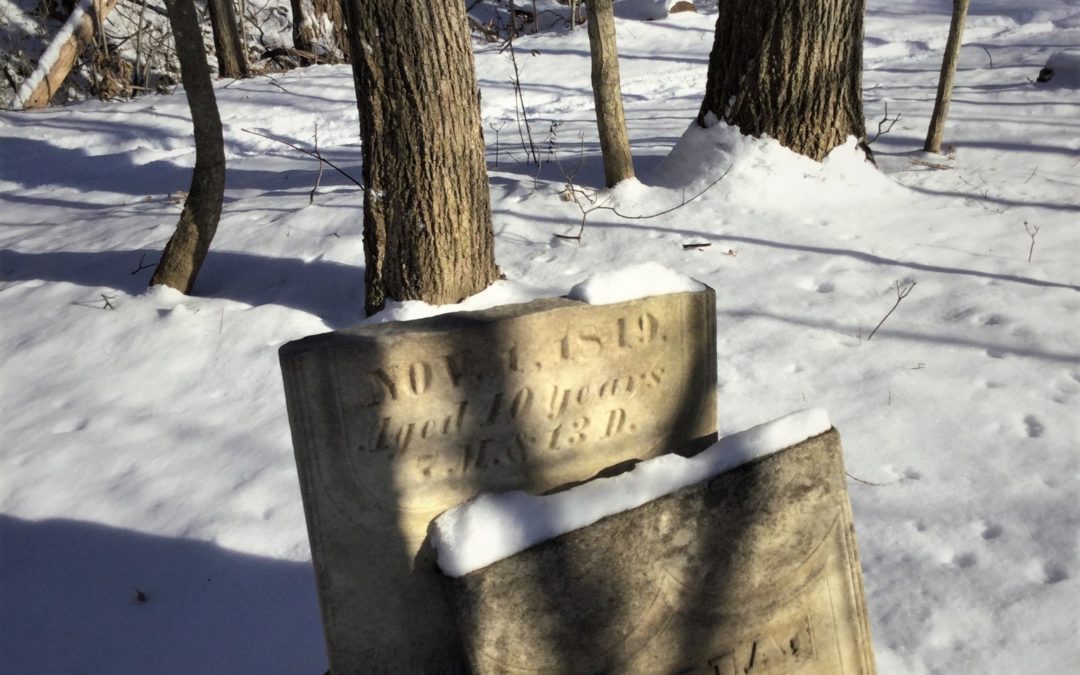I discovered a cemetery this week, or the remains of one. In the complex where I live, its name reflective of common health and good: a relic of 70’s utopia, American hippie style. Set in the middle of Nature, the compact, energy-efficient dwellings are individually owned, while the grounds and surrounding woods belong to all.
I was on my way to a laundry hut (which also belong to all). Not my habitual one just across the parking lot, where the coin-operated washing machine is busted, has been busted since Thanksgiving: we’re obviously not high on their Important Client list. This particular laundry hut requires more of a walk.
Between snug rows of little homes, now blanketed in white. Beyond the sidewalk and onto the footpath where dry leaves still crunch, beneath the snow. The ground not quite frozen yet. Down a makeshift wooden staircase, the steps set directly into the steep hill, across a rickety footbridge strung over a mini-ravine (carrying laundry all the while—haven’t fallen yet; I’m actually getting pretty good). A thigh-punishing climb up the other side, toujours avec laundry, a glance over at the picturesquely down-toppling fence that makes you want to recite Robert Frost.
And then laundry.
I’ve been doing this for nearly three weeks, and it was only yesterday, on the way back, going downhill instead of up, the sun shining so bright on the snow it hurt my eyes, that I discovered the cluster of tombstones. Or, rather, I saw them—they didn’t need “discovering.”
Maria, her given name beneath swags of drapery. A child, deceased on All Souls’ Day, 1819. Aged 10 years, 7 months and 13 days. Every moment of her short life treasured, by someone.
The stones made me think of my mother. She liked to do grave rubbings. Mostly out in the country, in rural Tennessee or Kentucky. Whenever she traveled with my father—once even as far as England, three years before she died, before she knew she was sick—she took her supplies. One of the rubbings from that trip, she framed. My father kept it. I wonder where it is now. There was an estate sale—grandiose term—before he moved to an assisted living facility. I was far away at the time. I hope the right person bought it.
Close to the beginning of his most recent novel, Berta Isla, Javier Marías (Maria, Marías—entirely coincidental) mildly marvels at the way we all walk about the earth, never stopping to think about what might be beneath it.
That might not be true all the time, though. Yes, some of the stones were disturbed at some point, by someone. But they were also carefully replaced, grouped together, in a protected spot. Protected but not isolated—they’re right beside the path. They are among us. Someone, as this complex was being built by idealistic hippy naturalists in the late 1970s, made that decision, maybe thinking she was acting like a Buddhist, or a Native American, or…something. Or just being human, toward other humans.
As I write this, I receive a message from our property manager: “our” washing machine is fixed. I think I might continue to use my neighbors’ for a while, though. The ravine-bridge-hill routine is good for my thighs.
And the little cluster of tombstones—Maria; the child; others whose names have grown so faint I can’t make them out—are good for something in me.
To all y’all out there, Happy Holidays. This is my final post for 2017—this is a somber, solitary, reflective time for me. I’ll post next in early January, from Dublin. Till then, may your world be beautiful.

